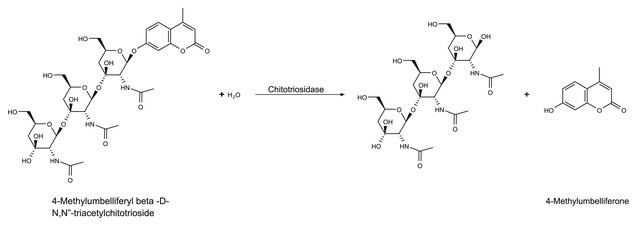추천 제품
일반 설명
The kit assay is based on the enzymatic hydrolysis of chitinase substrates. This enzymatic hydrolysis releases 4-methylumbelliferone (4MU), which upon ionization in basic pH, can be measured fluorimetrically at an excitation wavelength of 360 nm and an emission wavelength of 450 nm. The use of fluorimetric substrates provides a very sensitive detection system.
애플리케이션
The Chitinase Assay Kit provides all the reagents required for efficient and sensitive detection of chitinase activity in fungal and bacterial growth media, macrophage lysates, and purified enzyme preparations. In addition, the kit provides three different substrates for the detection of the various types of the chitinolytic activity:
- 4-Methylumbelliferyl N,N′-diacetyl-β-D-chitobioside - substrate suitable for exochitinase activity detection (chitobiosidase activity)
- 4-Methylumbelliferyl N-acetyl-β-D-glucosaminide - substrate suitable for exochitinase activity detection (β-N-acetylglucosaminidase activity)
- 4-Methylumbelliferyl β-D-N,N′,N′′-triacetylchitotriose - substrate suitable for endochitinase activity detection
생화학적/생리학적 작용
Chitinase catalyzes the hydrolytic cleavage of the β-1→4-glycoside bond present in biopolymers of N-acetylglucosamine, primarily in chitin. Chitinases are widely distributed in living organisms and are found in fungi, bacteria, parasites, plants, and animals. They are classified in families based on amino acid sequence similarities.
The chitinolytic enzymes are also categorized based on their enzymatic action on chitin substrates. Endochitinases are defined as the enzymes catalyzing the random cleavage at internal points in the chitin chain. Exochitinases catalyze the progressive release of acetylchitobiose or N-acetylglucosamine from the non-reducing end of chitin, and are referred to as chitobiosidase and β-N-acetylglucosaminidase, respectively.
Chitinases perform different functions in different organisms. In bacteria, they are mainly involved in nutritional processes. In yeast and various fungi, these enzymes participate in morphogenesis. In animals and plants, chitinases primarily play a role in the defense of the organism against pathogen attack.
The chitinolytic enzymes are also categorized based on their enzymatic action on chitin substrates. Endochitinases are defined as the enzymes catalyzing the random cleavage at internal points in the chitin chain. Exochitinases catalyze the progressive release of acetylchitobiose or N-acetylglucosamine from the non-reducing end of chitin, and are referred to as chitobiosidase and β-N-acetylglucosaminidase, respectively.
Chitinases perform different functions in different organisms. In bacteria, they are mainly involved in nutritional processes. In yeast and various fungi, these enzymes participate in morphogenesis. In animals and plants, chitinases primarily play a role in the defense of the organism against pathogen attack.
적합성
The kit was tested and found suitable for Trichoderma viride and Streptomyces griseus, along with Hela, Jurkat, CHO, NIH-3T3, U-837 mammalian cell lines, human macropages, rat lung, kidney, liver, and brain tissue.
제조 메모
Use ultrapure water for preparation of reagents.
키트 구성품 전용
제품 번호
설명
- Assay Buffer 25 mL
- 4-Methylumbelliferyl N-acetyl-β-D-glucosaminide 5 mg
- 4-Methylumbelliferyl β-D-N,N′-diacetylchitobioside hydrate 5 mg
- 4-Methylumbelliferyl β-D-N,N′,N′′-triacetylchitotriose 5 mg
- Chitinase from Trichoderma viride 1 mg
- 4-Methylumbelliferone Standard Solution, 50 mg/mL 1 mL
- Sodium Carbonate 2 g
- Dimethyl Sulfoxide 1 mL
모두 보기 (8)
신호어
Danger
유해 및 위험 성명서
Hazard Classifications
Eye Irrit. 2 - Resp. Sens. 1
Storage Class Code
10 - Combustible liquids
Flash Point (°F)
Not applicable
Flash Point (°C)
Not applicable
가장 최신 버전 중 하나를 선택하세요:
시험 성적서(COA)
Lot/Batch Number
이미 열람한 고객
Computational modeling and functional characterization of a GgChi: A class III chitinase from corms of Gladiolus grandiflorus
Rafiq M, et al.
The Kaohsiung Journal of Medical Sciences (2018)
S S Thimoteo et al.
Brazilian journal of medical and biological research = Revista brasileira de pesquisas medicas e biologicas, 50(1), e5658-e5658 (2017-01-12)
Chitinases are hydrolases that degrade chitin, a polymer of N-acetylglucosamine linked β(1-4) present in the exoskeleton of crustaceans, insects, nematodes and fungal cell walls. A metagenome fosmid library from a wastewater-contaminated soil was functionally screened for chitinase activity leading to
Daniel Hartmann et al.
Future oncology (London, England), 11(2), 193-203 (2014-07-22)
N-acetyl-glucosaminidase (NAG) is a potential marker of genotoxicity. We retrospectively analyzed plasma NAG and clinico-pathologic features in advanced gastrointestinal adenocarcinoma patients. Plasma from 118 patients and 51 healthy volunteers was analyzed for associations between NAG levels and age, disease presence
Zhangfa Song et al.
BMC cancer, 19(1), 629-629 (2019-06-27)
This study aimed to evaluate the value of chitinase activity in prognosticating the occurrence of metastasis in and prognosis of patients with colorectal cancer (CRC). The chitinase activity in four different groups, namely 335 CRC patients without distant metastasis at
Ying-ying Lu et al.
Journal of Zhejiang University. Science. B, 15(6), 566-574 (2014-06-07)
Aging is one of the contributing risk factors for kidney diseases. Accumulating evidence prompts the view that telomere length in kidney tissue cells is an indicator for organismal aging. Previously identified aging markers (cathelin-related antimicrobial peptide (CRAMP), stathmin, elongation factor-1α
자사의 과학자팀은 생명 과학, 재료 과학, 화학 합성, 크로마토그래피, 분석 및 기타 많은 영역을 포함한 모든 과학 분야에 경험이 있습니다..
고객지원팀으로 연락바랍니다.









